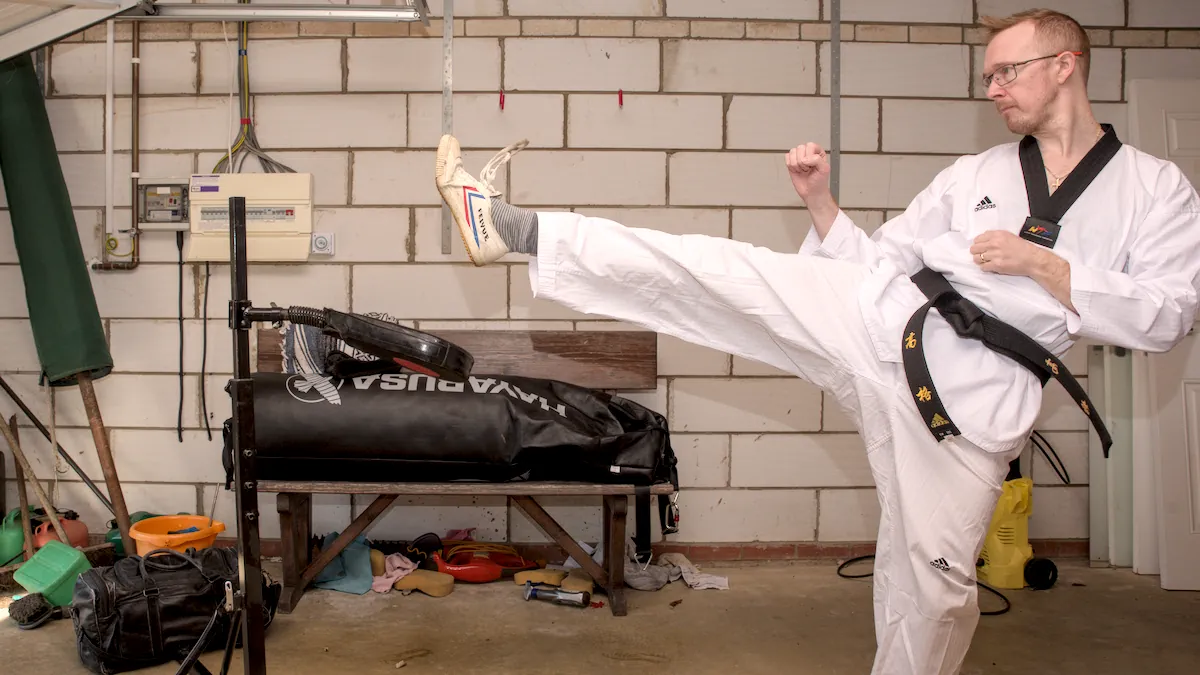Thinking about starting Taekwondo and want to know the Taekwondo belt order? There is nothing better than remembering back to when you were a white belt after finally getting your black belt. It can be a long road to travel, but with the information in this article, you’ll know everything there is to know about Taekwondo Belts.
In this ultimate guide to Taekwondo belts, you’ll find everything you need to know regardless of which style you practice.
Where Did Taekwondo Belts Come From?
You might be wondering why martial arts have belts anyway; here’s a brief history of how Taekwondo got its belts.
When I first started training in Taekwondo, my instructor told me the story of a student given a clean uniform and belt on his first day of class. But after the first month, his belt started to get stained yellow from the dirt floor he trained on. Over time the belt got more stained with dirt, sweat, and blood, eventually turning brown and finally black.
It’s a nice story, but it’s just a story. The actual origin of the martial arts belt was a judo master named Jigoro Kano. Kano played the ancient game of Go and saw that players’ levels were distinguished by a sash worn around the waist. Go has a rigid structure of levels starting at 25 kyu to 9 dan; each level represents a one-stone advantage.
Kano borrowed the terminology and the outward display by creating ranks for his new marital art, judo. In 1883 Kano introduced a two-belt system – white and black. He awarded the first Black Belts to Shiro Saigo and Tomita Tsunejiro, and later, he added three more belts.
Since then, colored belt systems have been used in almost every martial art in existence to differentiate students’ levels and create motivation for progress. Eventually, being passed on to Tang So Do and finally Taekwondo.
Taekwondo Ranks
Different Schools have slightly different ways of ranking their students, but every Taekwondo association recognizes gup and dan levels.
The gup levels correspond to the colored belts for students of Taekwondo, while the dan levels represent the master level denoted by black belts.
Kyup level counts down from 9 in WTF, ITF, and ATA styles; 1 gup is the highest level with a red belt and black tag.
Contrastingly, the dan levels go up from one to nine, with one dan being the lowest of the black belt ranks.
To achieve the next rank or grade, you’ll need to successfully complete a grading where you will be tested on the appropriate pattern, “poomsae,” board breaking, techniques, and sparring.
World Taekwondo (Previously World Taekwondo Federation (WTF) Belt Order)
The World Taekwondo Federation, headquartered at Kukiwon in Seoul, South Korea, is the body that oversees Taekwondo in the Olympics. Now rebranded as World Taekwondo (possibly due to the new common usage of “wtf” online,) its mission remains the same.
According to the World Taekwondo Website, its mission is:
“Develop and grow Taekwondo throughout the world, from a grassroots level all the way through to an elite level, to provide all with the opportunity to play, watch and enjoy the sport regardless of age, gender, religion, ethnicity or ability.”
The belt order of World Taekwondo (WTF) is as follows:
| Grading or Level | Belt Color | Representation |
|---|---|---|
| 10th Gup | White Belt | Emptiness |
| 9th Gup | White Belt Yellow Tag | |
| 8th Gup | Yellow Belt | Seed Planted in the Ground |
| 7th Gup | Yellow Belt Green Tag | |
| 6th Gup | Green Belt | First Growth |
| 5th Gup | Green Belt Blue Tag | |
| 4th Gup | Blue Belt | Growing Toward the Sky |
| 3rd Gup | Blue Belt Red Tag | |
| 2nd Gup | Red Belt | Blood |
| 1st Gup | Red Belt Black Tag | |
| 1st Dan | Black Belt | Master |
| 2nd Dan | Black Belt | |
| 3rd Dan | Black Belt | |
| 4th Dan | Black Belt | |
| 5th Dan | Black Belt | |
| 6th Dan | Black Belt | |
| 7th Dan | Black Belt | |
| 8th Dan | Black Belt | |
| 9th Dan | Black Belt | Grand Master |
International Taekwon-do Federation (ITF) Belt Order
The International Taekwon-do Federation, now headquartered in Spain, is the older of the two main Taekwondo associations. Sometimes called the North Korean Taekwondo style, It has less emphasis on sport in favor of more martial art and self-defense aspects.
First established in 1966, it keeps the same belt order as its World Taekwondo counterpart, although the forms “poomsae” or patterns “tul” needed for each grade isn’t the same.
Here is the belt order for ITF Taekwondo:
| Grading or Level | Belt Color | Representation |
|---|---|---|
| 10th Gup | White Belt | Emptiness |
| 9th Gup | White Belt Yellow Tag | |
| 8th Gup | Yellow Belt | Seed Planted in the Ground |
| 7th Gup | Yellow Belt Green Tag | |
| 6th Gup | Green Belt | First Growth |
| 5th Gup | Green Belt Blue Tag | |
| 4th Gup | Blue Belt | Growing Toward the Sky |
| 3rd Gup | Blue Belt Red Tag | |
| 2nd Gup | Red Belt | Blood |
| 1st Gup | Red Belt Black Tag | |
| 1st Dan | Black Belt | Master |
| 2nd Dan | Black Belt | |
| 3rd Dan | Black Belt | |
| 4th Dan | Black Belt | |
| 5th Dan | Black Belt | |
| 6th Dan | Black Belt | |
| 7th Dan | Black Belt | |
| 8th Dan | Black Belt | |
| 9th Dan | Black Belt | Grand Master |
American Taekwondo Association (ATA) Belt Order
The American Taekwondo Association (now ATA Martial Arts) is one of the largest Taekwondo organizations in the world, with over 300,000 members. Founded in 1969, ATA’s Songahm Taekwondo differs from the other traditional styles greatly.
This difference is reflected in the ATA Taekwondo Belt order.
| Grading or Level | Belt Color | Representation |
|---|---|---|
| Songahm 1 | White Belt | Purity |
| Songahm 2 | Orange Belt | Rising sun |
| Songahm 3 | Yellow Belt | Seed sees the light |
| Songahm 4 | Camouflage Belt | Sapling is hidden among trees |
| Songahm5 | Green Belt | Sapling growing |
| Inwha 1 | Purple Belt | Growing to the mountain |
| Inwha 2 | Blue Belt | Growing toward the sky |
| Choong Jung 1 | Brown Belt | Firmly rooted |
| Choong Jung 2 | Red Belt | Setting sun |
| 1st Degree (Recommended) | Red & Black Belt | New day |
| 2nd Degree | Black Belt | New permanence |
| 3rd Degree | Black Belt | Peace of mind |
| 4th Degree | Black Belt | Crest of granite mountain |
| 5th Degree | Black Belt | Master |
| 6th Degree | Black Belt | Long life |
| 7th Degree | Black Belt | Leadership role |
| 8th Degree | Black Belt | Moving forward to ideals |
| 9th Degree | Black Belt | Grand Master |
| 10th Degree | Black Belt | Eternal Grand Master |
Questions About Taekwondo Belts
How to Tie a Taekwondo Belt?
What Are Taekwondo Belts Made of?
Taekwondo Belts, like Karate belts or jiu-jitsu belts, are almost always made entirely of Cotton.
How Long Should My Taekwondo Belt Be?
Use this table to buy the right Taekwondo belt size for you. If you prefer a longer or shorter belt, adjust accordingly.
| Waist Size | Belt Length |
|---|---|
| 26″ | 102″ |
| 28″ | 106″ |
| 30″ | 110″ |
| 32″ | 114″ |
| 34″ | 118″ |
| 36″ | 122″ |
| 38″ | 126″ |
| 40″ | 130″ |
Can Children Earn Taekwondo Black Belts?
While children can reach 1st dan black belt level, they won’t receive their black belt until they are old enough (usually 16 years old.) Instead, they receive a “pooms” grade, which comes with a half-red, half-black belt. This belt is accompanied by a uniform with a matching collar.
Can You Learn Taekwondo at Home
While it is possible to learn a martial art by yourself at home with the use of video or online instructors, you will have much more success learning in a class. In a taekwondo class environment, you will be able to practice techniques and try sparring with the other students.
Also, without attending a taekwondo class, you will have no way of doing gradings or rising through the ranks and getting your colored belts or black belt.
What Should I Use for Adding Tags or Stripes to My Belt?
Before you start adding your own tags to your taekwondo belt, ask your instructor. Schools usually add tags for their students after they have passed their grading and achieved a new rank.
Electrical tape is what most schools use to add tags to belts. You can buy it cheaply online.
How Long Does It Take to Get a Taekwondo Black Belt
Most people who train in martial arts have a lifelong goal of earning a black belt. According to the ITF taekwondo encyclopedia, training for an hour and a half per day, three days per week, will earn you a 1st dan black belt in 30 months, which is two and a half years.
Get Training, and You’ll Achieve Your Next Belt Soon
Remember, belts in taekwondo are only a reflection of the hard work and training you’ve put in. So spend some more time practicing your patterns, kicks, breaking boards, and sparring, and you’ll smash your next grading in no time!






